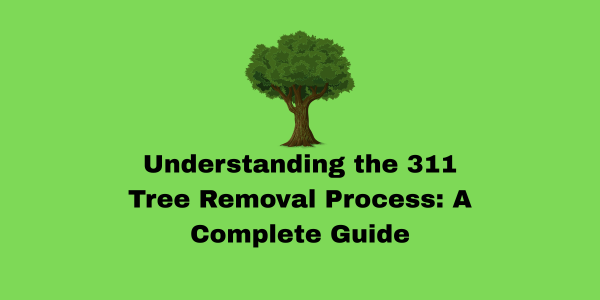Understanding the 311 Tree Removal Process: A Complete Guide
Trees make a space really vibrant, colorful and beautiful, improving air quality and enhancing property value. But, what happens sometimes is a tree may turn out dangerous or diseases, which has to be immediately removed. Here comes 311 tree removal process, a system to help people manage tree removal requests with safety measures and responsibility.
I will let you learn today how 311 tree removal process works and what you should know before filing a request.
What is a 311 Tree Removal Request?
In 311 tree removal request, you usually submit a report to alert the city authority to inspect, maintain or remove a tree. The system will ensure that forestry department officials come to assess the condition of your tree and take the necessary action so public safety and environmental protection should not be compromised.
To submit a 311 tree inspection request, you can either use a mobile app or directly place a call on 311. Some cities have an online 311 portal for citizens to file 311 tree removal requests with convenience.
Read also: How to Remove a Tree by Hand
Typical Steps in the 311 Tree Removal Process
1. Submitting a Request
The first step is contacting the city’s 311 system. You’ll need to provide:
- The exact address of the tree.
- The specific location (e.g., street median, sidewalk, parkway, or private yard).
- A clear description of the issue, such as “dead tree,” “leaning hazardously,” or “infested with pests.”
When your request filing is more detailed, the city authority will respond back more quickly with accurate information about moving forward process.
2. Inspection and Evaluation
Once the request is received, city staff or certified arborists will perform a site inspection.
They will assess:
- The overall health and stability of the tree.
- Signs of disease, pest infestation, or structural defects.
- Potential risks to people, vehicles, or buildings.
Some cities may require an official arborist’s report (especially for removals involving significant or protected trees).
3. Permits and Legal Considerations
Usually, a large tree removal or public tree removal, you will need a tree removal permit to move forward to ensure compliance with local regulations.
The permit process generally involves:
- Submitting documents like an arborist report, site plan, and photos.
- Paying a permit application fee.
- Providing notice to neighboring property owners if the tree borders other properties.
In many cities, certain trees — based on size, species, or historical significance — receive extra protection under municipal ordinances.
4. Public Notification and Hearings
If the tree is considered significant, the city may require public notification. For example, you must publicize a tree removal notice in San Francisco on tree at least 30 days before actioning upon it. If neighbors or the public object to the removal, a public hearing could be scheduled, allowing all parties to express concerns before a final decision is made.
5. Approval or Denial
After considering all factors, the city will either:
- Approve the removal and issue a removal permit, which must be posted visibly at the site, or
- Deny the request, often offering an appeal process if the applicant wishes to challenge the decision.
6. Tree Removal and Replacement
Once approved, the tree is removed either by the city or by the property owner (depending on location and responsibility).
Most cities require tree replacement as part of their urban forestry policies.
Applicants may need to:
- Plant a new tree (or multiple trees), or
- Pay a tree replacement fee that goes toward city tree planting programs.
Special Considerations in the 311 Tree Removal Process
- Dead or Hazardous Trees: These are often prioritized for faster inspection and removal to ensure public safety.
- Boundary Trees: Trees located on property lines may involve more complex legal processes and neighbor notifications.
- Tree Protection During Construction: If removal is related to a building project, special protections like fencing (hoarding) around nearby trees may be mandated.
- Costs: Tree removal costs, permit fees, and replacement obligations usually fall on the applicant, especially on private property.
Summary of the 311 Tree Removal Process
| Step | Description |
|---|---|
| Request Submission | Submit tree location and issue details via the city’s 311 system. |
| Inspection & Evaluation | Certified arborists inspect and assess the tree’s health and safety risk. |
| Permit Application | File necessary documents, pay fees, and notify neighbors if needed. |
| Public Notification | Post notices and manage public input or hearings if required. |
| Approval/Denial | Receive permit approval or denial, with an option to appeal. |
| Removal & Replacement | Tree removal is completed, often followed by replanting or paying a fee. |
Conclusion
The 311 tree removal process is a structured system designed to ensure that tree removals are conducted legally, safely, and thoughtfully. It ensures the safety of common people and public property with a broad vision to preserve the urban forestry. Understanding the steps — from submitting a request to complying with permits and replacement requirements — helps residents and property owners navigate the system efficiently while contributing to a greener, healthier community.
If you’re planning to file a tree removal request in your city, make sure you gather all the necessary information and understand your obligations to avoid delays and ensure compliance.
